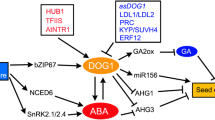Abstract
In the presence of ethylene, which enhances carnation flower senescence, carbohydrates contribute to ovary growth not only from the stem and calyx but also from the petals. With silver thiosulphate and ethanol treatments which delay flower senescence, the petals remain the active sink and ovary development is suppressed. Ethylene stimulated chloroplast development in the ovary wall. However, the calyx plus stem of all treatments showed the greater photosynthetic ability and transported a major portion of the synthesised products to the ovary.
Similar content being viewed by others
References
Aharoni N, Anderson JD and Lieberman M (1979) Production and action of ethylene in senescing leaf discs: Effects of indolacetic acid, kinetin, silver ion and carbon dioxide. Pl Physiol 64: 805–809
Aharoni N and Lieberman M (1979) Ethylene as a regulator of senescence in tobacco leaf discs. Pl Physiol 64: 801–804
Aharoni N, Lieberman M and Sisler HD (1979) Patterns of ethylene production in senescing leaves. Pl Physiol 64: 796–800
Camprubi P and Nichols R (1979) Effects of ethylene on carnation flowers (Dianthus caryophyllus) cut at different stages of development. J Hort Sci 53: 17–22
Carpenter WJ and Dilley DR (1974) Role of sucrose in cut flower longevity. Hort Sci 9: 297
Dimalla GG and Van Staden J (1980) The effect of silver thiosulphate preservative on the physiology of cut carnations. I. Influence on longevity and carbohydrate status. Z Planzenphysiol 99: 9–17
Ducasse P and Van Staden J (1981) Effect of silver thiosulphate preservative on the physiology of cut carnations. III. Regulation of (14C) sucrose transport and utilization. South African J Sci 77: 320–322
Gavinlertvatana P, Read PE and Wilkins HF (1980) Control of ethylene synthesis and action by silver nitrate and rhizobitoxine in Petunia leaf sections cultured in vitro. J Amer Soc Hort Sci 105 (3): 304–307
Halevy AH and Mayak S (1974) Improvement of cut flower quality opening and longevity by pre-shipment treatments. Acta Hort 43: 335–347
Halevy AH and Mayak S (1981) Senescence and postharvest physiology of cut flowers. Part 2. Hort Rev 3: 59–143
Harbourne JB (1973) Phytochemical methods: A guide to modern techniques of plant analysis. London: Chapman and Hall.
Harris GP and Jeffcoat B (1972) Distribution of 14C-labelled assimilates in flowering carnations plants. J Hort Sci 47: 25–35
Heins RED (1980) Inhibition of ethylene synthesis and senescence in carnations by ethanol. J Amer Soc Hort Sci 105 (4): 141–144
Heins RD and Blakely N (1980) Influence of ethanol on ethylene biosynthesis and flower senescence of cut carnations. Scientia Hort 13: 361–369
Laurie A (1936) A retrospect looking back ten years on floriculture research. Proc Amer Soc Hort Sci 34: 669–676
Kuc R and Workman M (1964) The relation of maturity to respiration and keeping quality of cut carnations and chrysanthemums. Proc Amer Soc Hort Sci 84: 575–581
Mayak S and Dilley DR (1976) Effect of sucrose on response of cut carnations to kinetin, ethylene and ABA. J Amer Soc Hort Sci 101: 583–585
Mor Y and Reid MS (1980) Isolated petals—a useful system for studying flower senescence. Acta Hort 113: 19–25
Mor Y, Reid MS and Kofranek AM (1980) Role of the ovary in carnation senescence. Scientia Hort 13: 377–383
Nichols R (1968) The response of carnations (Dianthus caryophyllus) to ethylene. J Hort Sci 48: 111–121
Nichols R (1975) Senescence and sugar status of the cut flower. Acta Hort 41: 21–29
Nichols R (1976) Cell enlargement and sugar accumulation in the gynoecium of the glasshouse carnation (Dianthus caryophyllus) induced by ethylene. Planta 130: 47–52
Nichols R (1977) A descriptive model of senescence of the carnation (Dianthus caryophyllus) inflorescence. Acta Hort 71: 227–232
Nichols R and Ho LC (1975) Effects of ethylene and sucrose on translocation of dry matter and 14C-sucrose in the cut flower of the glasshouse carnation (Dianthus caryophyllus) during senescence. Ann Bot 39: 287–296
Nichols R and Ho LC (1975) An effect of ethylene on the distribution of 14C-sucrose from the petals to other flower parts in the senescent cut infloresence of Dianthus caryophyllus. Ann Bot 39: 433–438
Purvis AC (1981) Sequence of chloroplast degreening in Calamondin fruit as influenced by ethylene and AgNO3. Pl Physiol 66. 624–627
Reid MS, Paul JL, Farhoomand MB, Kofranek AM and Staby GL (1980) Pulse treatments with the silver thiosulphate complex extend the vaselife of cut carnations. J Amer Soc Hort Sci 105: 25–27
Reynolds ES (1963) The use of lead citrate at high pH as an electronopague stain in electron microscopy. J Cell Biol 17: 208–212
Shimokawa K, Sakanoshita A and Horiba K (1978) Ethylene-induced changes of chloroplast structure in Satsuma mandarin (Citrus unshiu Marc). Pl Cell Physiol: 229–236
Sisler EC and Pian A (1973) Effect of ethylene and cyclic olefins on tobacco leaves. Tobacco Sci 17: 68–72
Sisler EC (1980) Role of carbon dioxide in reversing ethylene action in tobacco leaves. Tobacco Sci 24: 53–55
Van Staden J, Drewes SE and Hutton MJ (1982) Biological activity of 6-(2,3,4-trihydroxy-3-methylbutylamino) purine, an oxidation product of zeatin. Physiol Pl 55: 143–148
Warner HL and Leopold AC (1969) Ethylene formation from 2 chloroethyl-phosphonic acid. Pl Physiol 44: 156–158
Author information
Authors and Affiliations
Rights and permissions
About this article
Cite this article
Cook, E.L., Van Staden, J. Senescence of cut carnation flowers: Ovary development and CO2 fixation. Plant Growth Regul 1, 221–232 (1982). https://doi.org/10.1007/BF00024716
Received:
Revised:
Accepted:
Published:
Issue Date:
DOI: https://doi.org/10.1007/BF00024716




